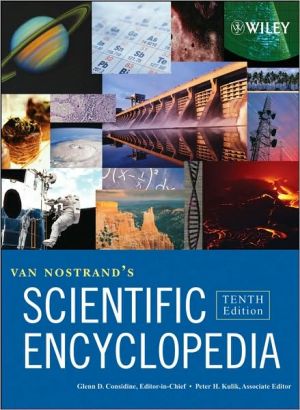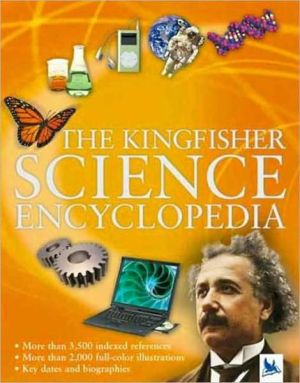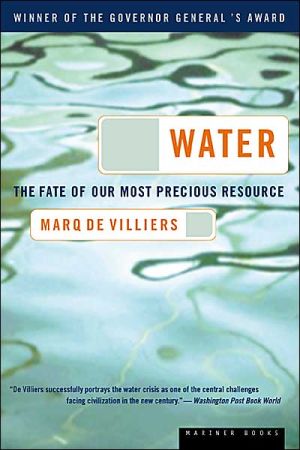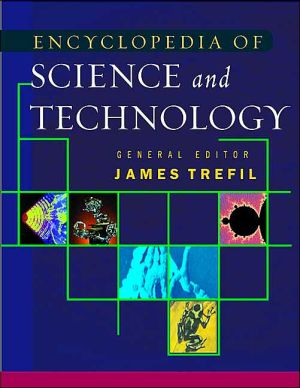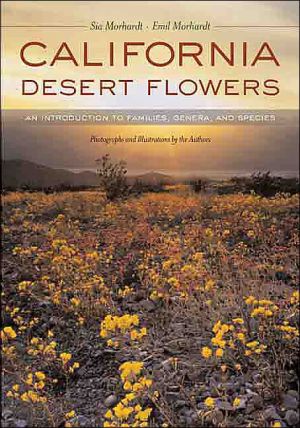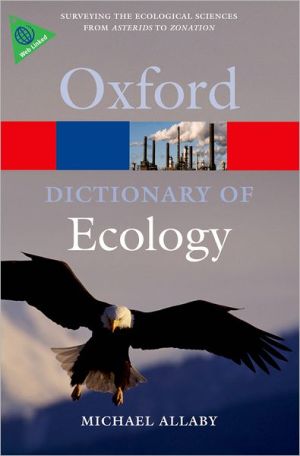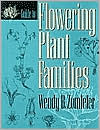Van Nostrand's Scientific Encyclopedia
The new, three-volume Tenth Edition contains articles contributed by industry experts and scholars worldwide. It comprises more than 10,000 entries and features hundreds of completely rewritten and re-referenced articles, as well as 2,500 completely new entries covering emerging technologies affecting genetics, global warming, communications, informatics, nanotechnology, and more. Internet references and print references have been updated and expanded to reflect the editors' conviction that...
Search in google:
The new, three-volume Tenth Edition contains articles contributed by industry experts and scholars worldwide. It comprises more than 10,000 entries and features hundreds of completely rewritten and re-referenced articles, as well as 2,500 completely new entries covering emerging technologies affecting genetics, global warming, communications, informatics, nanotechnology, and more. Internet references and print references have been updated and expanded to reflect the editors' conviction that modern students and researchers move from link to link as well as from page to page. Talanta As a source of scientific information it must be rated highly.
REPRESENTATIVE TOPICAL COVERAGE.ANIMAL LIFE. Amphibians. Annelida. Arthropods. Birds. Coelenterates. Echinoderms. Fishes. Insects. Mammals. Mesozoa. Mollusks. Paleontology. Protozoa. Reptiles. Rotifers. Zoology. BIOSCIENCES. Amino Acids. Bacteriology. Biochemistry. Biology. Biophysics. Cytology. Enzymes. Fermentation. Genetics. Hormones. Microbiology. Molecular Biology. Proteins. Recombinant DNA. Viruses. Vitamins. CHEMISTRY. Acids and Bases. Catalysts. Chemical Elements. Colloid Systems. Corrosion. Crystals. Electrochemistry. Free Radicals. Inorganic Chemistry. Ions. Macromolecular Science. Organic Chemistry. Oxidation-Reduction. Photochemistry. Physical Chemistry. Solutions and Sales. EARTH AND ATMOSPHERIC SCIENCES. Climatology. Ecology. Geochemistry. Geodynamics. Geology. Geophysics. Hydrology. Meteorology. Oceanography. Tectonics Seismology. Volcanology. ENERGY SOURCES AND POWER TECHNOLOGY. Batteries. Biomass and Wastes. Coal. Combustion. Electric Power. Geothermal Energy. Hydroelectric Power. Natural Gas. Nuclear Energy. Ocean Energy Resources. Petroleum. Solar Energy. Steam Generation. Tidal Energy. Turbines. Wind Power. MATHEMATICS AND INFORMATION SCIENCES. Automatic Control. Communications. Computing. Data Processing. Measurements. Navigation and Guidance. Statistics. Units and Standards. MATERIALS AND ENGINEERING SCIENCES. Chemical Engineering. Civil Engineering. Glass and Ceramics. Laser Technology. Mechanical Engineering. Metallurgy. Mining. Microelectronics. Plastics and Fibers. Process Engineering. Structural Engineering. Transportation. MEDICINE, ANATOMY, AND PHYSIOLOGY. Brain and Nervous System. Cancer and Oncology. Cardiovascular System. Chemotherapy. Dermatology. Diagnostics. Digestive System. Endocrine System. Genetic Disorders. Gerontology. Hematology. Immunology. Infectious Diseases. Kidney and Urinary Tract. Mental Illness. Muscular System. Ophthalmology. Otorhinolaryngology/Dental. Parasitology. Pharmacology. Reproductive System. Respiratory System. Rheumatology. Skeletal System. PHYSICS. Atoms and Molecules. Electricity. Electronics. Fluid State. Gravitation. Magnetism. Mechanics. Motion. Optics. Radiation. Solid State. Sound. Subatomic Particles. Surfaces. Theoretical Physics. Waves. PLANT SCIENCES. Agriculture. Algae. Botany. Diseases and Pests. Fruits. Fungi. Growth Modifiers. Nutritional Values. Plant Breeding. Seeds and Germ Plasm. Trees. Yeasts and Molds. SPACE AND PLANETARY SCIENCES. Astrochemistry. Astrodynamics. Astronautics. Astronomy. Astrophysics. Cosmology. Probes and Satellites. Solar Systems.
\ From the Publisher"This tool will likely find a home in most collections that deal with general science inquiries." (American Reference Books Annual, March 2009)\ "A good buy, this title effectively represents science in a condensed form that may be more affordable for many libraries than McGraw-Hill Encyclopedia of Science and Technology. Recommended." (CHOICE, October 2008)\ "The idea reference collection would include this new edition of VSNE…highly recommended for public school, and academic libraries." (Library Journal, August 15, 2008)\ \ \ \ \ \ TalantaAs a source of scientific information it must be rated highly.\ \ \ Library JournalScience reference works in print are doomed to obsolescence if not periodically updated. Those striving to cover the waterfront must expand their scope as scientists venture into new areas of study. The venerable Van Nostrand's Scientific Encyclopedia(VNSE), which has been around for 70 years, has grown to 10,000 entries and 6100 pages in this edition. It aims to be "approachable by students of many ages," and its accessibly written entries begin with simple definitions before getting into technical details. Entries range in length from one sentence to several pages, are cross-referenced, and may include black-and-white illustrations. The biographical entries are a bit shorter. Longer entries are signed and conclude with suggested additional reading. The longest entries have imbedded glossaries explaining related terms not warranting separate entries. Some entries include tidbits to engage nonscientists. For example, readers will learn that Charles Dickens visited Mount Vesuvius and wrote about it and that Italian mathematician Vito Volterra was inspired by reading Jules Verne. A generous 200-page index allows users to locate all relevant material. As might be expected in a work of this size, pages are thin and may easily tear. VNSE's closest competitor has been McGraw-Hill Concise Encyclopedia of Science & Technology(MHCEST), the latest edition (5th ed., 2004) of which is roughly half the size and cost of VNSE. MHCEST's content was drawn from a previous edition of the 20-volume McGraw-Hill Encyclopedia of Science & Technology(10th ed., 2007).\ —T.R. Faust\ \ \ \ \ \ Library JournalThis, the seventh edition of a well-known reference work, now appears in a two-volume format. That in itself is probably incentive enough to encourage replacement of the unwieldy sixth edition, published in 1983. Since there is little doubt that most local libraries have a copy of a scientific encyclopedia, the only question is whether this new edition has kept pace with the knowledge explosion. It has. The greatest changes are exactly where one would expect to find them. There are whole new sections on computer-related topics, such as local area networks (LANs) and machine vision; similarly, developments in materials science, such as the section on semiconductors, are given expanded coverage. Perhaps the most satisfying revisions are those on planetary astronomy, which incorporate the new information garnered by the Voyager fly-bys of the outer planets. Thus, the article on Uranus has been expanded from two to six pages, enough to provide a solid introduction for a student. One drawback is that certain broad topics are difficult to find; in mathematics, for example, there was no apparent entry for either chaos, catastrophe theory, or dynamical systems. Additionally, there is almost nothing on history of science or biography of scientists. Thus, if one looks up Fermi, one finds the definition of a unit of length but no mention that it was named after a person. Similarly, there is an article entitled ``Evolution,'' but nothing under Darwin. Nevertheless, this is probably the best scientific encyclopedia available.Harold D. Shane, Baruch Coll., CUNY\ \ \ \ \ From The CriticsFirst published in 1938, this desktop science encyclopedia has been published in two volumes beginning with the sixth edition. It is edited by Douglas Considine and Glenn Considine. Distinguished in their respective fields of engineering and information management, they are also the editors of several other well-known technical reference books (e.g., "Van Nostrand Reinhold Encyclopedia of Chemistry"). Approximately 250 scientists, engineers, and educators from eight different countries contributed to this new edition "Van Nostrand's" covers the six general areas of earth and space sciences, life sciences, energy and environmental science, materials science, physics and chemistry, and mathematics and information sciences. Where appropriate, entries have an identifying tag (e.g., "Bond" [Chemical]). The length of entries varies from one sentence ("Aeolian Tones") to 11 pages ("Climate"). Only the longer entries are signed by their authors and have appended reading lists. The entries appear to be current. For example, "Jupiter" mentions the "Ulysses" satellite flyby of the planet in 1992, and 13 new readings have been added to its bibliography. "Telescope" has been expanded from 8 to 12 pages, has several new illustrations, and its bibliography is twice as long. This entry mentions the 1993 corrections to the "Hubble Space Telescope". Similarly, the coverage under "Television" has been expanded to include a discussion of high-definition television, with mention of developments as recent as 1994. This work does not contain any biographies. Information on symbols and mathematical conversions is found under "Units and Standards" This encyclopedia has a good history of revision. A comparison with the previous edition shows that about 200 new pages have been added to the text. There are approximately 7,300 entries, an increase of several hundred. Throughout the text are many appropriately placed black-and-white photographs, line drawings, tables, charts, and diagrams. In the past this work has been criticized for the quality of its illustrations. There are several instances in this new edition of attempts to improve the contrast and size of photographs The index now appears at the end of each volume so the volumes can be used independently. A sampling determined that there are approximately 12,600 index entries and more than 5,300 cross-references in the text. This dual system of cross-references and indexing is barely adequate The only comparable work is the "McGraw-Hill Concise Encyclopedia of Science & Technology" ["RBB" N 15 94]. It has 7,700 alphabetically arranged entries, 1,700 illustrations, and an outstanding index of 30,000 citations. More than 3,000 authors contributed to the work, and all articles are signed. There is a bibliography of databases and appendixes of conversion units, symbols and abbreviations, and a classification of living organisms. In addition, there is a list of important scientists. "McGraw-Hill" is clearly superior in illustration quality and indexing. In contrast, "Van Nostrand's" has almost twice the number of pages and longer entries than "McGraw-Hill". Academic, public, and high-school libraries should consider "Van Nostrand's Scientific Encyclopedia" for their collections.\ \ \ \ \ BooknewsThis quick and easy to search CD-ROM contains an updated version of the 1996 two-volume eighth edition, about which wrote: "A new edition of the massive and definitive science encyclopedia (cited in and , originally appearing in 1938 and continuing its expansive tradition in this volume to include the most up to date scientific findings and controversies. umbrellas earth and space sciences, energy and environmental sciences, materials sciences, physics and chemistry, and mathematics and information sciences. Each major category is subdivided into its related parts and presented with careful attention to the social ramifications of the subject matter, as well as explaining material in a comprehensible and witty manner. Some of the new information tackled in this publication includes chaos theory, new glass processes, oncology, galaxy drift, and genetic mapping. Liberally salted with illustrations, photographs, and diagrams." Annotation c. Book News, Inc., Portland, OR (booknews.com)\ \
